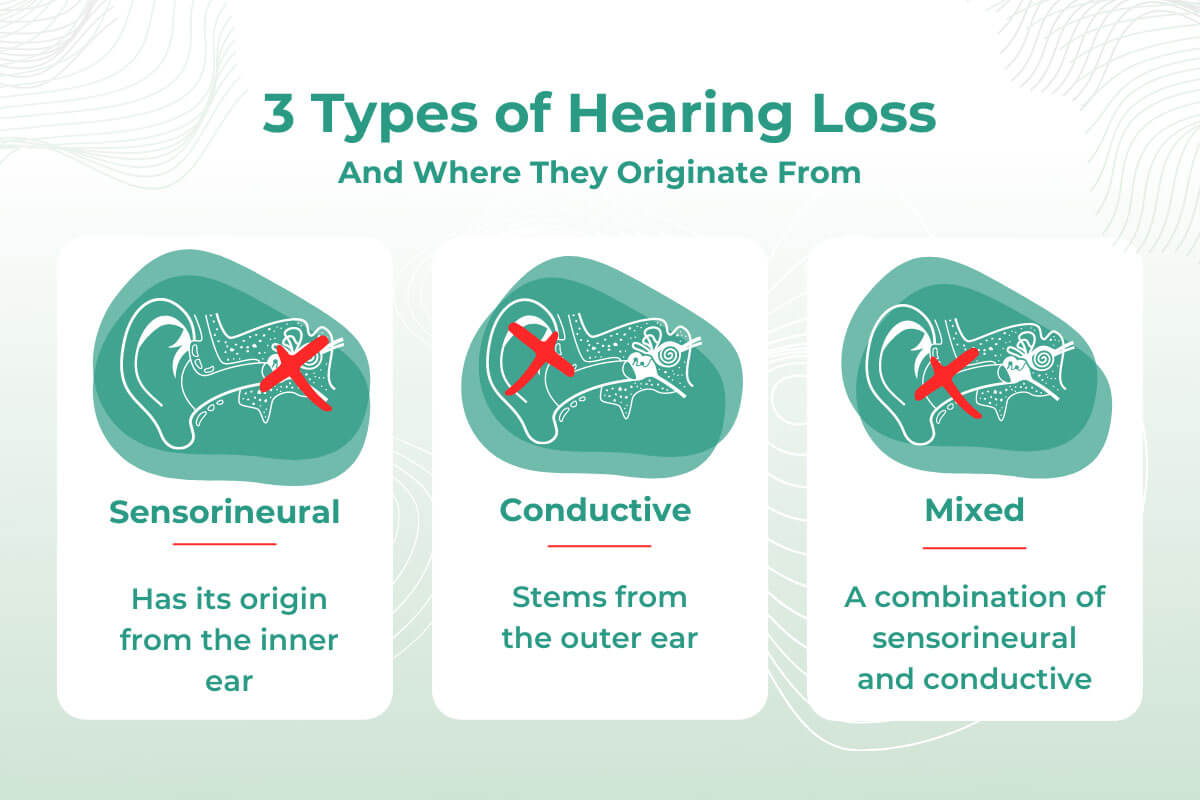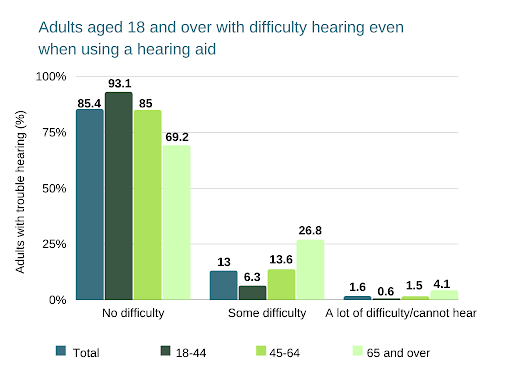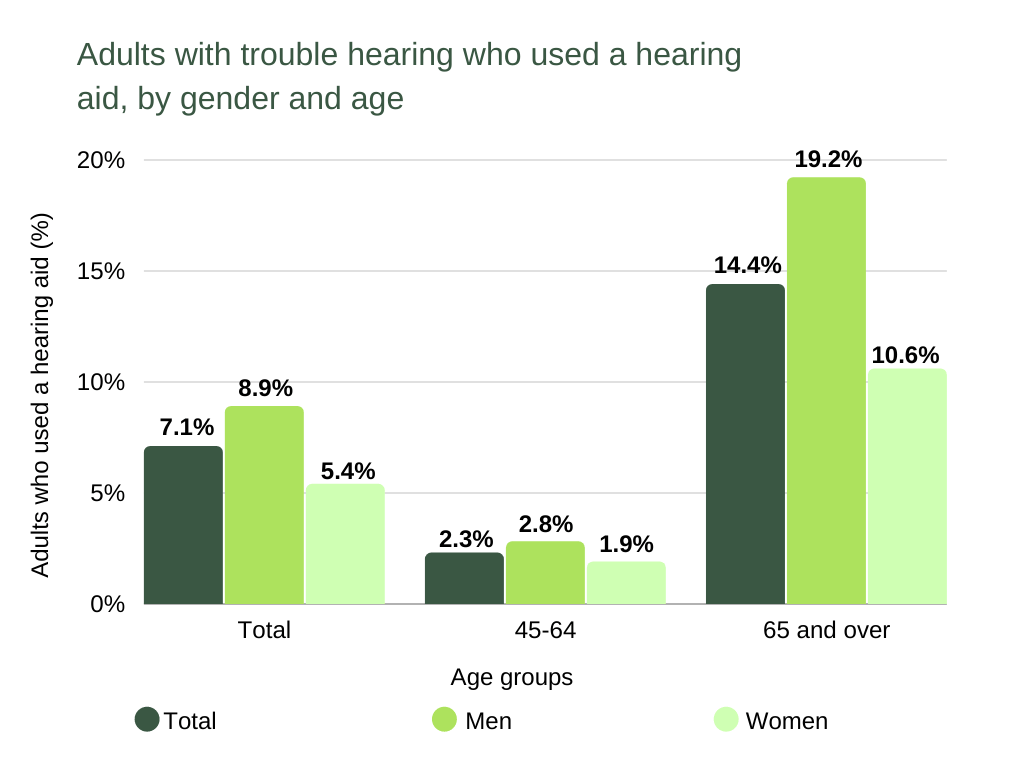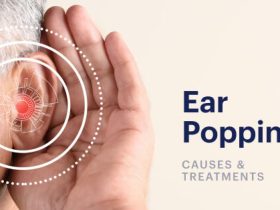When you’re struggling to hear what’s being said around you, the specific types of hearing loss may not seem to matter much. However, the truth is, it can matter a great deal.
The cause and type of hearing loss can tell you a lot about the symptoms and risks you may face. Most importantly, it can reveal the best ways to keep you connected to the people around you.
Key Takeaways: Types of Hearing Loss
- There are three general types of hearing loss, including sensorineural, conductive, and mixed.
- Sensorineural hearing loss involves damage to the inner ear or auditory nerve.
- Conductive hearing loss usually involves damage or illness in the outer or middle ear.
- Mixed hearing loss is a combination of both.
- There are 5 levels of hearing loss, from no loss to profound hearing loss.
- Hearing loss can have significant impacts on mental and general health.
- Hearing aids can be helpful, even with only a mild loss.
Types of Hearing Loss
There are several ways to divide types of hearing loss. However, it’s common to identify the type of hearing loss by the nature of the problem. By that measure, there are three types of hearing loss:

- Sensorineural hearing loss.
- Conductive hearing loss.
- Mixed hearing loss.
To understand those divisions, it’s first necessary to understand how normal hearing works. The normal ear consists of three parts, the outer, middle, and inner ear. Sound waves are collected in the outer ear, then travel down the ear canal. The eardrum in the middle ear turns sound into vibration, which becomes neural signals in the inner ear. Each type of hearing loss interferes in a part of that process.
Conductive Hearing Loss
Conductive hearing loss occurs most often due to physical damage or an obstruction in the middle or outer ear. There could be a number of causes, including:
- A foreign body in the middle ear space.
- Ear infections like otitis externa.
- A congenital problem, such as with the external ear.
- Osteosclerosis in the ear.
Sound transmission depends on vibrations, first in the air, then the ear canal, and then in the tympanic membrane, better known as the eardrum. Vibrations travel to the ossicles, or small bones called malleus, incus, and stapes. If sound vibrations are blocked or muted, this type of hearing loss may occur.
Conductive hearing loss can sometimes be reversed, by surgical correction or removing blockages like foreign objects. However, if left uncorrected, permanent and significant conductive hearing loss could result. Early treatment can prevent further hearing loss or a more serious surgical intervention [1].
Conductive hearing loss may initially be diagnosed using a tuning fork to perform the Rinne test [2]. Formal audiometry is usually required for a definitive diagnosis. Symptoms may include:
- Difficulty hearing high-pitched sounds.
- Vertigo.
- Chronic ear infections.
- Sound generally seems quieter [3].
Sensorineural Hearing Loss
Sensorineural hearing loss usually has its origin in the inner ear and involves damage to the auditory nerve. Common age-related hearing loss is usually considered to be sensorineural loss [4]. It is usually a form of permanent hearing loss.

Source: https://www.cdc.gov/nchs/products/databriefs/db414.htm
Once sound passes into the ear canal and turns into vibration in the middle ear, the inner ear turns it into electrical signals. Small hair cells pick up the vibrations of the middle ear. The motion of those hairs is what turns the vibration into electrical signals. The signals then travel down the hearing nerve to the auditory cortex in the brain. This type of hearing loss can be caused by problems at any point in that process.
A doctor may perform the Weber test to check for sensorineural hearing loss [5].
As mentioned, a certain amount of hearing loss is a part of normal aging. Other than age-related changes, causes of sensorineural hearing loss include:
- Head trauma.
- Congenital conditions.
- Trauma from loud noises.
- Viral infections.
- Some medications.
Common symptoms include:
- Tinnitus.
- Loud sounds are softer.
- Softer sounds may be too soft or too loud.
- Vertigo.
Sensorineural hearing loss can be further divided into several types of hearing loss, including:
- Presbycusis or age-related hearing loss.
- Noise-induced hearing loss.
- Meniere’s disease.
- Autoimmune sensorineural hearing loss.
Mixed Hearing Loss
Mixed hearing loss combined aspects of both conductive hearing loss and sensorineural hearing loss. In other words, there is both a physical obstruction and damage to the auditory nerve.
There may be one cause that affects both the inner ear and middle ear. For example, foreign bodies might damage delicate hair cells. In some cases, it might be two different causes, such as age-related hearing loss combined with osteosclerosis.
What Are the 5 Levels of Hearing Loss?
Hearing impairment is judged by the severity of loss in the affected ear. It may be in one ear, called asymmetrical hearing loss, or both in bilateral hearing loss. The first level is 0: No impairment. The remaining four hearing levels are:
- Slight impairment: Able to hear words spoken in a normal voice.
- Moderate impairment: Able to hear words spoken in a raised voice.
- Severe impairment: Able to hear some words when shouted.
- Profound impairment, including deafness: Unable to hear even loud noises.
A hearing test called a pure tone audiogram is used to determine the level of hearing loss. An audiologist will play several tones of different frequencies at different intensities, to determine the limits of your hearing. Further examinations may follow.
Do I Need a Hearing Aid?

Source: https://www.cdc.gov/nchs/products/databriefs/db414.htm
Many people have some degree of hearing loss, either sensorineural hearing loss or conductive hearing loss. Despite that, only about 14% of people who could benefit use hearing aids [6]. However, the impact of hearing loss can go far beyond playing the TV too loud. Consequences of hearing loss can be profound:
- Social isolation.
- Lack of independence.
- Depression.
- Early dementia.
Children may also have difficulty learning speech sounds.
The first sign of hearing loss is often trouble hearing high pitch sounds like alarms or higher voices. It may come in one ear or both. Even basic aids are helpful, while the best hearing aids have many features to make life easier. Hearing aids may be one of several treatment options available.
How To Get Your Hearing Tested
Your usual doctor may be the best place to start. They can perform a pair of simple tuning fork tests, the Weber and Rinne test, used in evaluating hearing loss. A tuning fork test can only detect hearing loss in one ear. For example, when testing for conductive hearing loss, a comparison between hearing sounds conducted by air, or through the bone, must be made for both ears.
A more formal test probably requires a trip to the audiologist, who will play a variety of low and high-pitched sounds into a patient’s ear. They can then judge the exact range of hearing loss of the affected ear.
Online tests can also be a good place to start. The best online hearing tests use a process similar to an audiologist, though less precise.
Types of Hearing Aids
Most people are familiar with conventional hearing aids. Some options may be better depending on the type of hearing loss. Varieties include:
- Behind-the-ear: These sit behind the ear with a tube carrying sound into the ear. They are easy to manipulate, with several different volume settings.
- Receiver-in-the-canal: This entire hearing aid sits in the ear canal, offering better sound and higher amplification, with a lower chance of feedback. They are more liable to degradation and not recommended for those with frequent ear infections.
- Custom-shape: The most discreet option, this option includes the in-the-ear, in-the-canal, and completely-in-the-ear. They are useful in contexts with noisy backgrounds, but small batteries mean less amplification.
Modern hearing aids may also have Bluetooth connectivity, fine-tuning through an app, or a range of other fancy features [7].
Conventional aids may be less helpful when the problem is conductive hearing loss. Other options include bone-anchored hearing aids (BAHA) and cochlear implants. Both bypass the middle ear. BAHAs use bone conduction to transmit sound to the inner ear. Cochlear implants create a link directly to the auditory nerve [8].
FAQ
Looking for answers to a specific question regarding hearing loss? See if it’s among these frequently asked questions.
How Do You Know If Hearing Loss Is Sensorineural or Conductive?
The only real way to know is to visit your doctor, who might be able to give you an answer after a couple of simple tuning fork tests. It may be difficult to determine which is the cause on your own, as it may involve damage to the middle ear or inner ear.
The context of the hearing loss may be able to give you some idea. If you recently heard a loud noise, it’s probably sensorineural hearing loss. A recent ear infection will more likely result in conductive hearing loss. It can be difficult to know by symptoms alone.
How Can I Check My Hearing at Home?
Home tests can’t really substitute for or provide medical advice. However, you might be able to use a simple tuning fork to at least get an idea of any potential hearing loss.
There are actually two tuning fork tests you can perform, the Rinne test and the Weber test. They both use the idea of the air-bone gap, the fact that we hear sound more clearly through air conduction than bone conduction.
To perform the Rinne test, cover the ear you’re not testing. Place a vibrating tuning fork on your jaw bone, or mastoid bone, below your ear. Note for how long you can hear the tone.
Do the same thing, but now hold the tuning fork beside your ear. If you can hear the tone longer through the bone conduction than through the air conduction, you may have conductive loss. You’ll need to do both the right ear and left ear.
To perform the Weber test, place a vibrating tuning fork on the center of the temporal bone, right in the center of your forehead. If the sound is ‘loudest’ on the midline, you have normal hearing. If it’s louder to one side or the other, you may have sensorineural hearing loss.
How Can I Restore My Hearing Naturally?
There has been some study of treating hearing loss with vitamins, acupuncture, and other alternative treatments [9]. The results have been mixed, particularly as there is a lack of high-quality research on some treatments. As a result, it’s difficult to recommend any natural treatment.
If you’ve had hearing loss confirmed through a hearing test, your doctor can provide more guidance.
What Vitamins Help Hearing?
There is evidence that some vitamins can play a role in the development of healthy hearing. Vitamins that may help include:
Note that these are most effective in preventative health care and probably won’t reverse existing hearing loss.
Conclusion
Hearing loss isn’t just aggravating, it can have a significant impact on wider health. Hearing loss can make it more difficult to learn speech sounds, or even speed the onset of early dementia. However, understanding the different types of hearing loss is the first step to making informed choices about treatment.
References:
- Sooriyamoorthy, Thushanth. “Conductive Hearing Loss.” StatPearls [Internet]., U.S. National Library of Medicine, 30 Aug. 2021, https://www.ncbi.nlm.nih.gov/books/NBK563267/.
- Kong, Erwin L. “Rinne Test.” StatPearls [Internet]., U.S. National Library of Medicine, 4 May 2021, https://www.ncbi.nlm.nih.gov/books/NBK431071/.
- Zahnert T. (2011). The differential diagnosis of hearing loss. Deutsches Arzteblatt international, 108(25), 433–444. https://doi.org/10.3238/arztebl.2011.0433.
- Tanna, Ravina J. “Sensorineural Hearing Loss.” StatPearls [Internet]., U.S. National Library of Medicine, 30 Aug. 2021, https://www.ncbi.nlm.nih.gov/books/NBK565860/.
- Wahid, Nur Wahidah B. “Weber Test.” StatPearls [Internet]., U.S. National Library of Medicine, 9 Feb. 2021, https://www.ncbi.nlm.nih.gov/books/NBK526135/.
- Warren, Elizabeth. “Over-the-Counter Hearing Aids-The Path Forward.” JAMA Internal Medicine, JAMA Network, 1 May 2017, https://jamanetwork.com/journals/jamainternalmedicine/article-abstract/2606426.
- Schuster-Bruce, James. “Conventional Hearing Aid Indications and Selection.” StatPearls [Internet]., U.S. National Library of Medicine, 13 July 2021, https://www.ncbi.nlm.nih.gov/books/NBK567712/.
- Brodie, Arjuna, et al. “The Impact of Rehabilitation on Quality of Life after Hearing Loss: A Systematic Review.” European Archives of Oto-Rhino-Laryngology, Springer Berlin Heidelberg, 23 Aug. 2018, https://link.springer.com/article/10.1007/s00405-018-5100-7.
- Chen, Shanwen, et al. “Acupuncture for the Treatment of Sudden Sensorineural Hearing Loss: A Systematic Review and Meta-Analysis: Acupuncture for SSNHL.” Complementary Therapies in Medicine, Churchill Livingstone, 21 Dec. 2018, https://www.sciencedirect.com/science/article/abs/pii/S0965229918304217.
- Ghazavi, Hossein, et al. “Investigation of Vitamin D Levels in Patients with Sudden Sensory-Neural Hearing Loss and Its Effect on Treatment.” American Journal of Otolaryngology, W.B. Saunders, 12 Nov. 2019, https://www.sciencedirect.com/science/article/abs/pii/S0196070919309214.
- Alvarado, Juan C., et al. “An Oral Combination of Vitamins A, C, E, and Mg++ Improves Auditory Thresholds in Age-Related Hearing Loss.” Frontiers, Frontiers, 31 July 2018, https://www.frontiersin.org/articles/10.3389/fnins.2018.00527/full#h6.





Leave a Reply